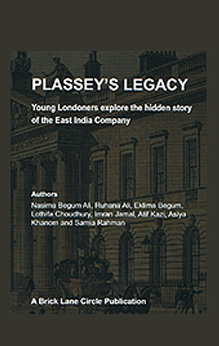
Author: Ruhana Ali, Imran Jamal, Lothifa Chowdhury, Nasima Ali, Eklima Begum, Atif Kazi, Asiya Khanom, Samia Rahman
Genre: India
Publisher: Brick Lane Circle
Release Date: 20 April 2010
Format: Paperback
Pages: 178
Source: No longer available on the website
‘Plassey’s Legacy’ presents the essays of young Muslims who explored the connections between their historical past and their present British-Bangladesh identity. The collection takes its name from the famous military encounter in Bengal in 1757 when Colonel (later Lord) Robert Clive defeated the last Nawab of Bengal, Sirajuddaula, thus opening the way for unfettered commercial exploitation of the land by the East India Company. The authors’ efforts were inspired by Dr Muhammad Ahmedullah, Secretary of the Brick Lane Circle in the East End of London, and project coordinator.
A dedication at the start of this collection captures a vision, “To all young minds who want to understand their past in order to bring about positive change in our world”. At a time when the majority of students at school drop History as a subject when moving from Key Stage 3 to Key Stage 4, and are thus unlikely to pursue it at ‘A’ levels and beyond, this publication is exemplary in demonstrating how the subject can be made absorbing, relevant and formative.
The Introduction, by Dr Ahmedullah notes, “the successes and benefits that the [East India] Company achieved for Britain also had devastating consequences for India and Bengal in particular. This book brings some of the shared history to light and hopes to generate wide interest through sharing knowledge about East India Company’s London heritage and the city’s historical links with Bengal and India….
The book starts with a chapter by Samia Rahman…she walks us through eight London-based East India Company sites and illuminates the history behind these places….Imran Jamal’s chapter Two on the evolution of the East India Company Army throws light on how the Company recruited its army of British officers and sepoys and the differential benefits and conditions experienced by them. Chapter Three is on Tea, written by Ruhana Ali, and is of particular interest to Bangladeshi people of Sylheti origin as the region is renowned for its beautiful tea gardens…the East India Company’s tea operations in Sylhet may explain the origin of Sylheti migration into London….Lothifa Choudhury looks in Chapter Four at the impact that the Company had back home in London. In Chapter Five Nasima Begum Ali looks at the main reasons why the East India Company declined, beginning with an exploration of mismanagement and taking in the failures during the Sepoy Mutiny of 1857…Atif Kazi looks at the processes and mechanisms utilized by the government to disperse the assets of the Company in Chapter Six. In Chapter Seven, Asiya Khanum provides a brief report on an interesting project…taking a group of young people on a tour of East India Company sites…the last chapter is written by Elima Begum who discusses the personal impact of the project had on her and what she gained as a person, including relating her grandfather’s experience of working in the East India Docks in the 1930s.”
All the authors were under 25 when they participated in this venture. ‘Plassey’s Legacy’ is also to be valued for its rich collection of photographs of past and present.
